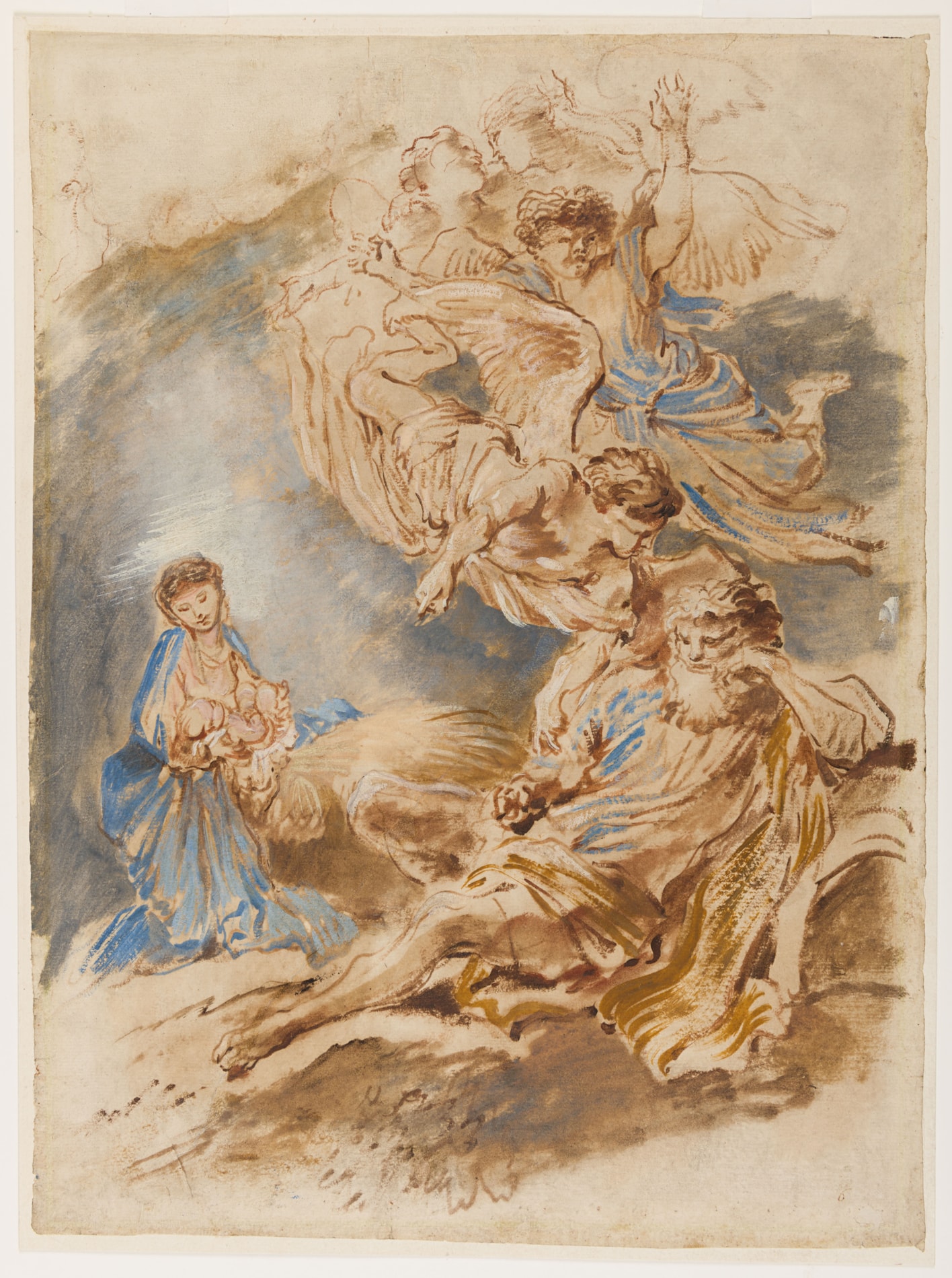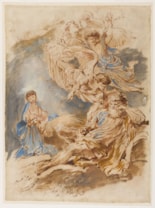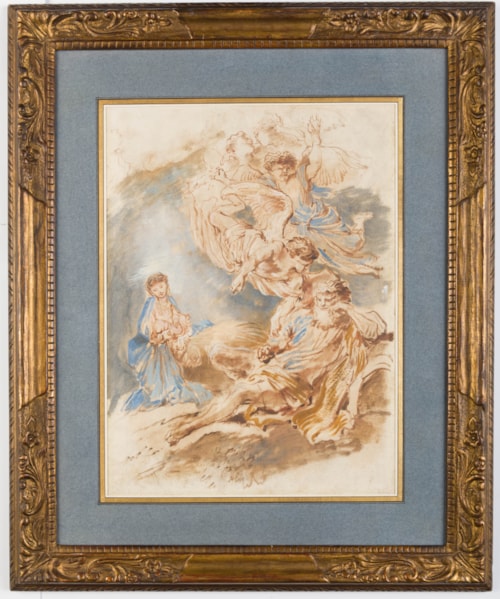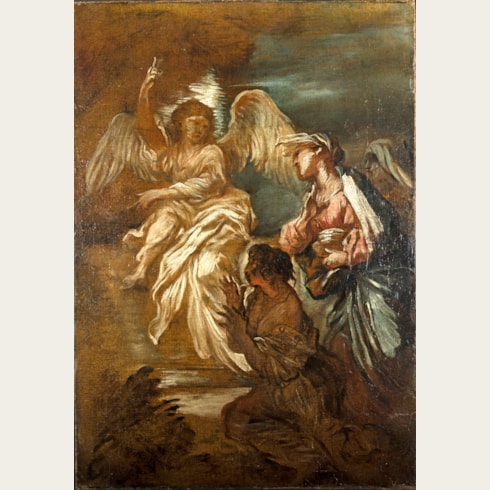Giovanni Benedetto CASTIGLIONE
(Genoa 1609 - Mantua 1664)
The Nativity or The Angel Instructing Joseph to Flee with his Family to Egypt
Brush and brown ink and ochre wash, with white heightening, and touches of pink, blue and reddish-brown oil paint.
Made up at the upper left corner and a small made-up area at the lower centre.
A repaired tear in the upper left quadrant and another repaired tear extending diagonally across the sheet.
Laid down.
440 x 324 mm. (17 3/8 x 12 3/4 in.)
Made up at the upper left corner and a small made-up area at the lower centre.
A repaired tear in the upper left quadrant and another repaired tear extending diagonally across the sheet.
Laid down.
440 x 324 mm. (17 3/8 x 12 3/4 in.)
The present sheet is a fine example of the practice of dry-brush drawing on untreated paper that Castiglione made distinctively his own. The innovative technique of drawing with oil paint applied directly onto the sheet with the brush resulted in a group of drawings that are among the artist’s best-known works. Using coarsely-ground pigment mixed with linseed oil, Castiglione was able to achieve remarkable effects, with brown pigment used for the forms and shadows (often smudged to suggest animal fur) contrasted with blue paint in the sky and areas of white paper left untouched to create highlights. In these works, Castiglione is likely to have been inspired by the oil sketches of Rubens and Van Dyck, which he would have seen in Genoa. As the scholar Anthony Blunt has suggested, ‘the brush drawings are in a completely personal technique, invented by the artist himself. He may have been trying to produce an equivalent on paper for the rapid oil sketches which Rubens and van Dyck made on lightly primed wooden panels, but the effect is novel because the oil with which the pigment is mixed sinks into the paper and blurs the edges of the brushstrokes, giving them added subtlety...Castiglione achieved a great variety of effects with this technique. It can be light and almost feathery in his gayer scenes, powerful and dramatic in his grander, more Baroque religious subjects, or savagely expressive in his very late drawings.’
Despite their seemingly unfinished appearance, Castiglione’s brush drawings seem to have been conceived and made as independent works for sale, rather than preparatory studies or working drawings, although their compositions are sometimes replicated in his pictures. They are usually difficult to date, since they can only rarely be directly associated with paintings, but the earliest are thought to date from the 1630s, with the majority produced after the middle of the 1640s. In general, it appears that earlier in his career Castiglione’s brush drawings in oil are handled in a looser, more fluid manner than his later studies, which have a more elaborate, finished quality. Blunt has noted of such brush drawings that ‘The pigment used varies at different periods from a yellowish or even greenish brown, to a fairly strong orange, and in the late drawings to a dull crimson. In the early sketches the whole effect is obtained by sharp, clearly defined brush strokes, but in the later works semi-transparent washes are used, and in some cases the sky and parts of the figures are finished with ordinary oil paint mixed in the normal way with a binding medium. This method had great advantages for an artist of Castiglione’s particular temperament. It is a rapid and fluent technique which enables the painter – one cannot really say draughtsman in this context – to obtain with a few strokes a striking, if sometimes rather superficial effect. It is well suited to the lively baroque form of composition which Castiglione used, particularly in his later period. It offers no opportunity for the careful, thoughtful formulation employed by a Poussin, but such a conception of art was in any case entirely foreign to Castiglione.’
Castiglione was particularly fond of the theme of the Nativity or Adoration of the Shepherds, which was repeated with variations in a number of brush drawings, as well as in monotypes. This fine brush drawing is likely to date from the last years of the artist's career. As has been noted, ‘By the late 1650s Castiglione’s working procedure was entirely internalised, and increasingly his expressiveness outweighed the descriptive function of the drawings…he applied successive layers of drier and more opaque red-brown earth colours over initial markings of liquid yellowish-brown stains, then set off the composition with accents of pale blue-greys and off-whites, sometimes even violets, and a smattering of illegible stray lines to hint at unresolved components of the composition. In their unfinished painterly state, these drawings appeal strongly to our modernist sensibilities, revealing much of his creative process as he built up the image…Castiglione’s prodigious creative capacities remained undimmed even at the end of his artistic journey.’
Although a late work by the artist, and probably datable to the late 1650s or early 1660s, it may be noted of the present sheet that the pose of the Virgin and Child is reminiscent of the same figure group in Castiglione’s monumental altarpiece of The Adoration of the Shepherds, signed and dated 1645, in the church of San Luca in Genoa, which is one of the artist’s earliest dated works, and among his most celebrated. An almost identical figure of the reclining Saint Joseph also appears in a brush drawing of The Angel Appearing to Saint Joseph in the Royal Collection at Windsor Castle.
An analogous, albeit somewhat smaller, brush drawing of The Penitence of Saint Peter by Castiglione - which was, like the present sheet, at one time in the notable collection of the American banker and philanthropist Jules Semon Bache (1861-1944) - was on the art market in New York in 1999. Stylistic comparisons may also be made with a brush drawing of The Adoration of the Shepherds, formerly in the Mariette collection and today in the Hermitage in St. Petersburg and another of Angels Adoring the Virgin and Child in the Nationalmuseum in Stockholm.
Despite their seemingly unfinished appearance, Castiglione’s brush drawings seem to have been conceived and made as independent works for sale, rather than preparatory studies or working drawings, although their compositions are sometimes replicated in his pictures. They are usually difficult to date, since they can only rarely be directly associated with paintings, but the earliest are thought to date from the 1630s, with the majority produced after the middle of the 1640s. In general, it appears that earlier in his career Castiglione’s brush drawings in oil are handled in a looser, more fluid manner than his later studies, which have a more elaborate, finished quality. Blunt has noted of such brush drawings that ‘The pigment used varies at different periods from a yellowish or even greenish brown, to a fairly strong orange, and in the late drawings to a dull crimson. In the early sketches the whole effect is obtained by sharp, clearly defined brush strokes, but in the later works semi-transparent washes are used, and in some cases the sky and parts of the figures are finished with ordinary oil paint mixed in the normal way with a binding medium. This method had great advantages for an artist of Castiglione’s particular temperament. It is a rapid and fluent technique which enables the painter – one cannot really say draughtsman in this context – to obtain with a few strokes a striking, if sometimes rather superficial effect. It is well suited to the lively baroque form of composition which Castiglione used, particularly in his later period. It offers no opportunity for the careful, thoughtful formulation employed by a Poussin, but such a conception of art was in any case entirely foreign to Castiglione.’
Castiglione was particularly fond of the theme of the Nativity or Adoration of the Shepherds, which was repeated with variations in a number of brush drawings, as well as in monotypes. This fine brush drawing is likely to date from the last years of the artist's career. As has been noted, ‘By the late 1650s Castiglione’s working procedure was entirely internalised, and increasingly his expressiveness outweighed the descriptive function of the drawings…he applied successive layers of drier and more opaque red-brown earth colours over initial markings of liquid yellowish-brown stains, then set off the composition with accents of pale blue-greys and off-whites, sometimes even violets, and a smattering of illegible stray lines to hint at unresolved components of the composition. In their unfinished painterly state, these drawings appeal strongly to our modernist sensibilities, revealing much of his creative process as he built up the image…Castiglione’s prodigious creative capacities remained undimmed even at the end of his artistic journey.’
Although a late work by the artist, and probably datable to the late 1650s or early 1660s, it may be noted of the present sheet that the pose of the Virgin and Child is reminiscent of the same figure group in Castiglione’s monumental altarpiece of The Adoration of the Shepherds, signed and dated 1645, in the church of San Luca in Genoa, which is one of the artist’s earliest dated works, and among his most celebrated. An almost identical figure of the reclining Saint Joseph also appears in a brush drawing of The Angel Appearing to Saint Joseph in the Royal Collection at Windsor Castle.
An analogous, albeit somewhat smaller, brush drawing of The Penitence of Saint Peter by Castiglione - which was, like the present sheet, at one time in the notable collection of the American banker and philanthropist Jules Semon Bache (1861-1944) - was on the art market in New York in 1999. Stylistic comparisons may also be made with a brush drawing of The Adoration of the Shepherds, formerly in the Mariette collection and today in the Hermitage in St. Petersburg and another of Angels Adoring the Virgin and Child in the Nationalmuseum in Stockholm.
Sometimes known as ‘il Grechetto’, the Genoese artist Giovanni Benedetto Castiglione received his training in the studio of Giovanni Battista Paggi and, following Paggi’s death in 1627, with Giovanni Andrea de’ Ferrari. He may also have studied with Anthony Van Dyck, who was in Genoa between 1621 and 1627, and the animal painter Sinibaldo Scorza, whose work seems to have had the most influence on the young artist. Like Scorza, he developed a particular penchant for animal paintings, landscapes, pastoral scenes and Old Testament subjects. He was also highly regarded as a portrait painter, although only a very few examples have been identified today. Castiglione’s earliest signed and dated painting was executed in 1633 in Rome, but he first established his reputation in his native city. For much of his career, he was regarded as one of the finest painters in Genoa, producing altarpieces and canvases for churches and palaces all over the city, and his fame eventually spread throughout Italy. In the later part of his career Castiglione began to produce paintings and drawings that were intensely religious in feeling.
Apart from working extensively in Genoa, Castiglione travelled widely and was active in Venice, Parma, Naples and Rome, where he worked for several years in the 1630s and again between about 1647 and 1651. From 1651 onwards he worked mostly in Mantua, where he was employed by the Gonzaga court, and where he died in 1664. As Jonathan Bober has summed up the artist’s career, ‘Castiglione was, beyond the quintessential Genoese artist, a genius of the highest order. He was not responsible for any of the basic languages of the Italian baroque, or even any of the major currents in the art of his native city. But by restless nature, genuine intellect, and seemingly boundless imagination, he attended to more styles, and synthesized them more thoroughly, than any other artist of the school, if not the entire seventeenth century.’ Despite not having many pupils or followers of note, apart from his brother Salvatore and son Francesco, as well as the Neapolitan painter Andrea de Leone, Castiglione’s influence on later Genoese painting was profound and long lasting. As another scholar has written, ‘Grechetto’s art is at the very core of the “decorative trend” of Genoese Baroque painting. Without him there would never have existed Gregorio de Ferrari, Domenico Piola, even Gaulli.’
Castiglione has always been better known for his extraordinary graphic output than his paintings. He was a prolific and spirited draughtsman, working mainly in pen and wash, and made numerous drawings not just as studies for painted compositions but as works of art in their own right. He was also a gifted printmaker, and may well be credited with the invention of the monotype process. As noted by James Byam Shaw, ‘[Castiglione] was something of a wild character, and there is wild grandeur in his style of painting, drawing, and etching.’ The largest surviving group of drawings and oil sketches by Castiglione, amounting to more than two hundred sheets, is today in the Royal Collection at Windsor Castle.
Apart from working extensively in Genoa, Castiglione travelled widely and was active in Venice, Parma, Naples and Rome, where he worked for several years in the 1630s and again between about 1647 and 1651. From 1651 onwards he worked mostly in Mantua, where he was employed by the Gonzaga court, and where he died in 1664. As Jonathan Bober has summed up the artist’s career, ‘Castiglione was, beyond the quintessential Genoese artist, a genius of the highest order. He was not responsible for any of the basic languages of the Italian baroque, or even any of the major currents in the art of his native city. But by restless nature, genuine intellect, and seemingly boundless imagination, he attended to more styles, and synthesized them more thoroughly, than any other artist of the school, if not the entire seventeenth century.’ Despite not having many pupils or followers of note, apart from his brother Salvatore and son Francesco, as well as the Neapolitan painter Andrea de Leone, Castiglione’s influence on later Genoese painting was profound and long lasting. As another scholar has written, ‘Grechetto’s art is at the very core of the “decorative trend” of Genoese Baroque painting. Without him there would never have existed Gregorio de Ferrari, Domenico Piola, even Gaulli.’
Castiglione has always been better known for his extraordinary graphic output than his paintings. He was a prolific and spirited draughtsman, working mainly in pen and wash, and made numerous drawings not just as studies for painted compositions but as works of art in their own right. He was also a gifted printmaker, and may well be credited with the invention of the monotype process. As noted by James Byam Shaw, ‘[Castiglione] was something of a wild character, and there is wild grandeur in his style of painting, drawing, and etching.’ The largest surviving group of drawings and oil sketches by Castiglione, amounting to more than two hundred sheets, is today in the Royal Collection at Windsor Castle.
Provenance
Jules S. Bache, New York
Anonymous sale, London, Sotheby’s, 2 July 1997, lot 11 Galerie de Bayser, Paris, in 1998
Jean Bonna, Geneva.
Anonymous sale, London, Sotheby’s, 2 July 1997, lot 11 Galerie de Bayser, Paris, in 1998
Jean Bonna, Geneva.
Literature
Nathalie Strasser, Carnets d’études 4: Dessins italiens de la collection Jean Bonna, exhibition catalogue, Paris, 2006, pp.46-47, no.24; Nathalie Strasser, Dessins italiens de la Renaissance au siècle des lumières: Collection Jean Bonna, Geneva, 2010, pp.220-221, no.97 (where dated c.1650).
Exhibition
Paris, École Nationale Supérieure des Beaux-arts, Dessins italiens de la collection Jean Bonna, 2006, no.24.






